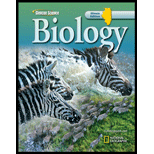
Concept explainers
Introduction : An organism is called bipedal when it can walk upright on two legs. One of the genus, hominins while becoming bipedal, developed a fully upright stance, shortened arms, restructured pelvic bones and foot bones.
Answer to Problem 18A
Correct answer :
The correct answer is option (c) divergence.
Explanation of Solution
Explanation/justification for the correct answer :
Option (c): A. afarensis were of the size as chimpanzee and had typical australopithecine skull and small brain. Their arms were long in proportion to their legs, and they had fingers and bones were more curved than those of modern humans. This trait indicated that A. afarensis could be arboreal.
However, this species had humanlike hip and knee joints and could walk upright. Later, it was concluded by Mary Leakey that australopithecine were bipedal from their fossilized footprints.
This shows that A. afarensis had divergent evolutionary pattern. In divergent evolution, two groups of the same species seem to evolve different traits within those groups to accommodate for differing environmental and social pressures.
Explanation for incorrect answer :
Option (a) convergence evolution is the process when organisms are not monophyletic, which means that they are not closely related, evolve similar traits independently in course of adaptation of similar environments or ecological niches.
Option (b) mosaic evolution occurs when different body parts or behaviors evolve at different rates.
Option (d) coevolution occurs between pairs of species or among groups of species when they interact with one another. In this, the process of reciprocal evolutionary change is seen.
Hence, A. afarensis was bipedal, but she exhibited apelike traits shows divergence evolution.
Chapter 16 Solutions
Biology Illinois Edition (Glencoe Science)
Additional Science Textbook Solutions
Chemistry: Structure and Properties (2nd Edition)
Physics for Scientists and Engineers: A Strategic Approach, Vol. 1 (Chs 1-21) (4th Edition)
Organic Chemistry (8th Edition)
Microbiology: An Introduction
Genetic Analysis: An Integrated Approach (3rd Edition)
Cosmic Perspective Fundamentals
 Human Anatomy & Physiology (11th Edition)BiologyISBN:9780134580999Author:Elaine N. Marieb, Katja N. HoehnPublisher:PEARSON
Human Anatomy & Physiology (11th Edition)BiologyISBN:9780134580999Author:Elaine N. Marieb, Katja N. HoehnPublisher:PEARSON Biology 2eBiologyISBN:9781947172517Author:Matthew Douglas, Jung Choi, Mary Ann ClarkPublisher:OpenStax
Biology 2eBiologyISBN:9781947172517Author:Matthew Douglas, Jung Choi, Mary Ann ClarkPublisher:OpenStax Anatomy & PhysiologyBiologyISBN:9781259398629Author:McKinley, Michael P., O'loughlin, Valerie Dean, Bidle, Theresa StouterPublisher:Mcgraw Hill Education,
Anatomy & PhysiologyBiologyISBN:9781259398629Author:McKinley, Michael P., O'loughlin, Valerie Dean, Bidle, Theresa StouterPublisher:Mcgraw Hill Education, Molecular Biology of the Cell (Sixth Edition)BiologyISBN:9780815344322Author:Bruce Alberts, Alexander D. Johnson, Julian Lewis, David Morgan, Martin Raff, Keith Roberts, Peter WalterPublisher:W. W. Norton & Company
Molecular Biology of the Cell (Sixth Edition)BiologyISBN:9780815344322Author:Bruce Alberts, Alexander D. Johnson, Julian Lewis, David Morgan, Martin Raff, Keith Roberts, Peter WalterPublisher:W. W. Norton & Company Laboratory Manual For Human Anatomy & PhysiologyBiologyISBN:9781260159363Author:Martin, Terry R., Prentice-craver, CynthiaPublisher:McGraw-Hill Publishing Co.
Laboratory Manual For Human Anatomy & PhysiologyBiologyISBN:9781260159363Author:Martin, Terry R., Prentice-craver, CynthiaPublisher:McGraw-Hill Publishing Co. Inquiry Into Life (16th Edition)BiologyISBN:9781260231700Author:Sylvia S. Mader, Michael WindelspechtPublisher:McGraw Hill Education
Inquiry Into Life (16th Edition)BiologyISBN:9781260231700Author:Sylvia S. Mader, Michael WindelspechtPublisher:McGraw Hill Education





